Kapan Anda mulai menyelam?
I got certified in 1992 on the Great Barrier Reef in Queensland, Australia. For the next five years I dived in Turkey, Thailand, and on the shipwrecks of Scapa Flow in the Orkney Islands, Scotland — all over the place. In 1997 I completed instructor training at Bass Lake in South Africa and then started teaching in Wales, where I lived. My wife and I moved to Western Australia in 1999, and I opened a diver training facility at the local boat dealership. Life was pretty good for a few years, and I issued more than 500 certifications from basic open-water diver to technical decompression diving.
It was quiet in the winter there, so I went back to university and earned a bachelor’s degree in training and development. After that, I spent another two years researching dive injuries while earning my master’s degree in public health. I then closed the dive business to focus on dive research, and around that time I took up cave diving.
Di mana Anda menyelesaikan gelar doktor Anda?
Pada tahun 2005 saya bertanya kepada almarhum Richard Vann, Ph.D., apakah saya dapat mengerjakan program doktoral saya bersamanya, namun saya ingin tetap tinggal di University of Western Australia (UWA). Setelah berdiskusi, beliau memutuskan bahwa membagi program saya di antara dua universitas tidak akan berhasil, jadi pada tahun 2006 saya mulai di UWA. Pada tahun 2007, Vann mengundang saya untuk melamar magang di DAN. Lamaran saya berhasil, dan dia menjemput saya di bandara pada akhir Mei.
Ada cukup banyak peserta magang pada tahun itu, dan kami semua dilatih untuk mengumpulkan data untuk Project Dive Exploration (PDE). Setelah seminggu, yang lain terbang ke berbagai tujuan menyelam, dan saya tetap di DAN bersama Erin dari South Carolina dan Alex dari Colorado. Kami mengerjakan proyek di kantor DAN atau Universitas Duke selama seminggu dan menyelam di akhir pekan. Alex dan saya melakukan 135 kali penyelaman di enam negara bagian pada musim panas itu. Studi observasi pertama kami menunjukkan bahwa batas tanpa dekompresi dalam buku petunjuk komputer selam bukanlah panduan yang dapat diandalkan untuk mengetahui seberapa konservatifnya komputer untuk menyelam di danau di ketinggian.
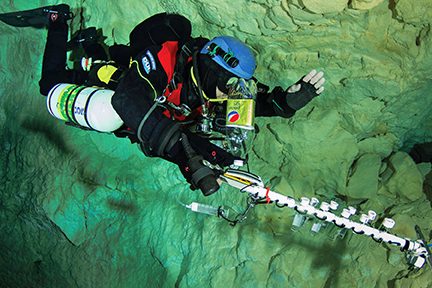
Apa yang Anda lakukan setelah magang berakhir?
I returned to Western Australia and continued collecting data for PDE — more than 1,500 dive profiles in all. Meanwhile, I dived, usually in caves, and then I finished my doctorate and presented my findings at the European Underwater and Baromedical Society meeting in Istanbul, Turkey. The Norwegian professor and dive researcher Alf Brubakk, M.D., Ph.D., was one of my examiners, and he chaired the morning session before I presented my results. I was nervous, but a month later I learned that he passed my thesis with only minor corrections.
Saat itu saya sudah bersertifikat untuk menyelam trimix dengan kadar oksigen rendah (trimix hipoksia), yang saya gunakan untuk menyelam di gua-gua yang sangat dalam. Saya menghabiskan beberapa tahun berikutnya menyelam di tambang di Swedia, menyelam di gua-gua Polandia, dan menjelajahi gua-gua raksasa yang dipenuhi air sedalam 300 kaki di bawah Dataran Nullarbor, dataran tinggi batu kapur yang sangat luas di pantai selatan Australia Tengah. Di situlah saya menyelam saat ini.
Bagaimana Anda bisa berakhir di Eropa?
After finishing my doctorate, I was wondering what to do next when I received an email inviting me to apply for a two-year postdoctoral fellowship in decompression research as part of the Physiopathology of Decompression (PHYPODE) Project at the Université de Bretagne Occidentale in France. On Christmas Day 2012, my wife and I arrived in Brest, France. The university did not reopen until January 4, which gave us a couple of weeks to explore.
On my first day, I walked to work carrying a small French-English pocket dictionary, counting my steps along the way. “Une, deux, trois.” By the time I got to work, I could count in French.
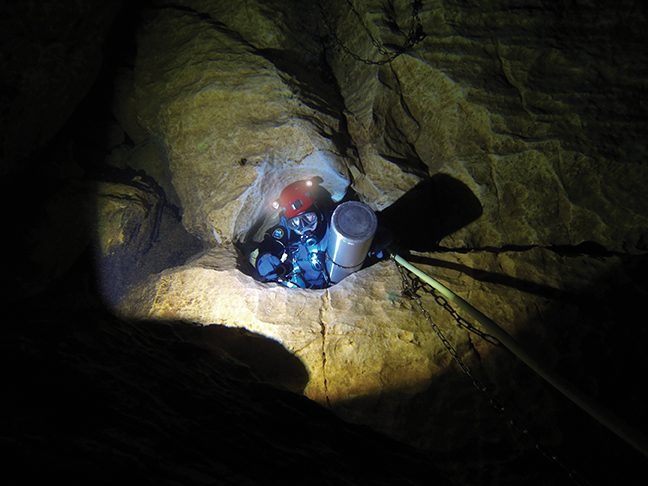
Apa yang Anda lakukan di sana?
The work was fascinating, and François Guerrero, Ph.D., was a delight to work for and very demanding. He would encourage us to aim higher, submit our results to better journals, and make the most of every opportunity that came our way. I mentored three doctoral students — one researching cultured cells, one decompressing rats, and one using human subjects. In addition to helping them, I looked at population-level epidemiological data. This time in my career was highly productive, and I made some dear friends with whom I still work.
I cave dived all over France and northern Italy on weekends and holidays. Other trips took me to lakes in Germany, shipwrecks in Croatia, flooded buildings underneath Budapest, and mines in Belgium, Slovakia, and a few other countries. I even won a research grant to visit Brubakk’s lab in Norway. While there, I flew to Rana, Norway, and dived in the arctic Plura Cave.
Between all this diving, we worked on our interests in decompression sickness’s genetic determinants. We imagined what it would be like if we had a test that could tell us if someone’s genes were upregulated and they were peaking in terms of protection right before a big dive. We designed a selective breeding program and bred a strain of rat that was highly resistant to decompression, and this work continues.
Apa yang Anda lakukan selanjutnya?
As this wonderful time ended, Petar Denoble, M.D., D.Sc., offered me a position at DAN. My wife and I sold our home and moved to North Carolina. It was fantastic — I published a lot of dive research over the next few years and made a lot of dives spanning 20 states. DAN sent me to give talks at dive shows and dive clubs, which I really enjoyed. I gave 32 presentations in my last year at DAN. The dive clubs were the best. I’d give a talk to a packed room, and then we’d go for dinner somewhere. I’d end up at a table with people who had been diving all their lives. There could be 150 years of dive experience at the table, and the plentiful dive stories came out fast, especially if you mentioned the “old days.”
Meanwhile, I was the DAN Annual Diving Report editor, and I was running the DAN Internship program. I had come full circle. During my time at DAN, I published a few epidemiology papers I still consider among my best work. I worked on estimating the risk of dive injuries in recreational divers, which is still my focus. Everyone else — military divers, dive scientists, etc. — has someone closely looking after them, but recreational divers are a fascinating bunch.
Di mana kamu sekarang?
In July 2018, after three and a half years at DAN, I accepted an offer at Curtin University in Perth, Western Australia. Now I am the director of graduate research, which means I help all the master’s and doctoral students stay on track. I also teach one unit, applied paramedic bioscience, which I really enjoy. The rest of my time I spend on my own research, by which I mean my doctoral students’ research.
Saya masih berkolaborasi dengan para peneliti di luar universitas saya. Tahun lalu saya memenangkan DAN/Alfred Bove Research Grant, yang saya gunakan untuk membangun laboratorium basah di fasilitas ruang hiperbarik kami yang baru. Kami memiliki mahasiswa doktoral yang mempelajari gelembung dan fungsi jantung pada penyelam rekreasi dan berencana untuk menambahkan yang ketiga untuk melihat narkosis nitrogen. Hibah ini merupakan kesempatan yang sangat baik untuk menumbuhkan generasi baru ilmuwan selam.
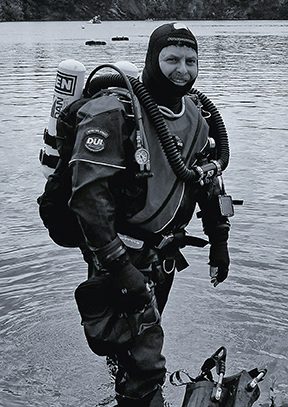
What’s left that you want to discover?
There is one big question I haven’t yet answered but would like to: Does diving add to our life expectancy or reduce it? I’m also interested in whether deep vein thrombosis in commercial airline passengers is a form of decompression sickness and how we can identify recreational divers who are prone to bubbles after diving. I can’t pin it down for you — there is too much in the world that holds my interest. There just aren’t enough hours in the day.
I never looked back — I still do both kinds of work. I get to switch from basic science in the lab one day to being an attending physician in the emergency department the next, and I’m delighted with how things have worked out.
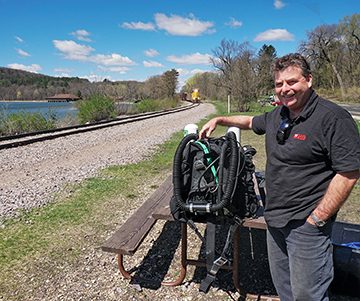
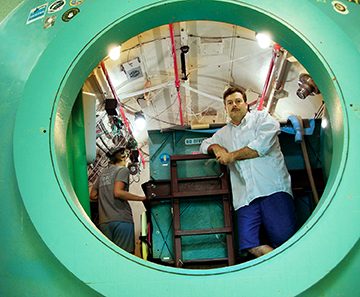
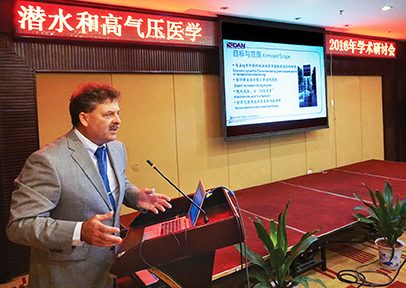
Foto: Foto: Atas izin Peter Buzzacott
© Alert Diver — Q2 2022